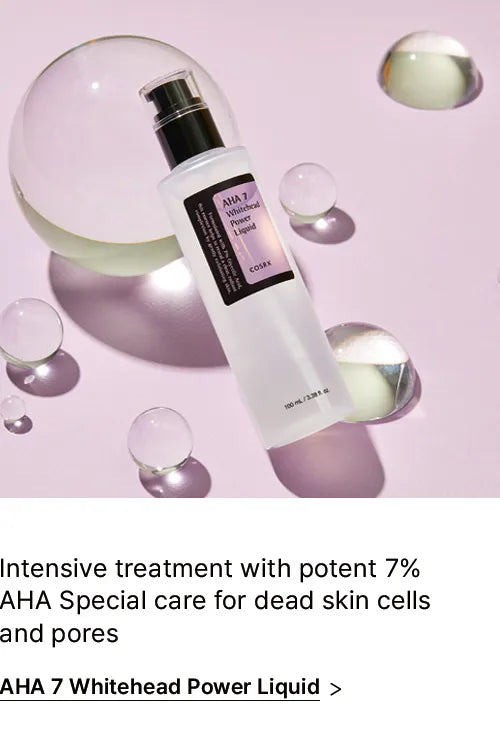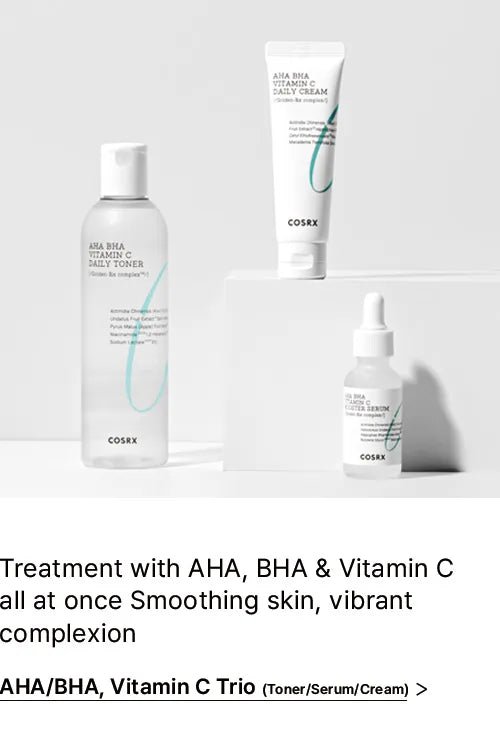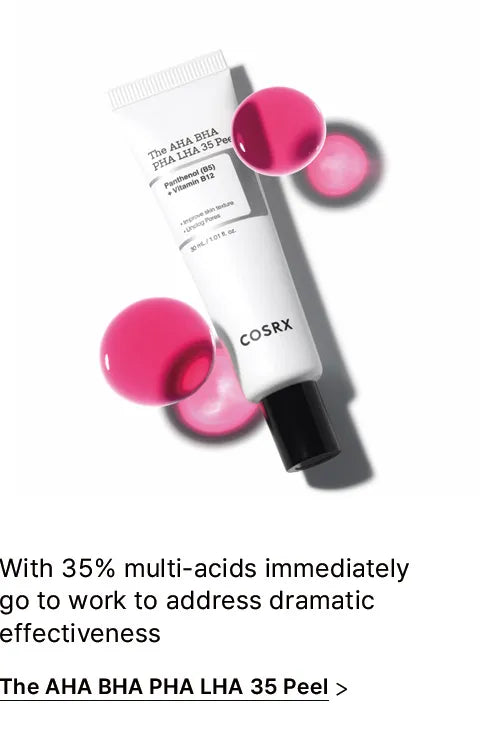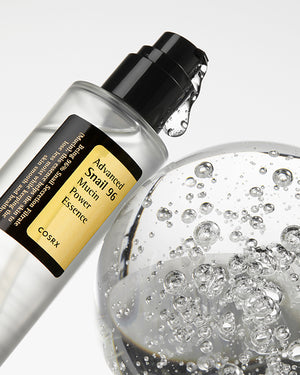Everything about AHA
AHA is one of the signature ingredients in COSRX. You probably think of it first as an ingredient to soften skin texture and exfoliate dead skin cells. In fact, AHA has many other skin benefits beyond exfoliation. Let's take a look at various functions of AHA and when it's best to use it.
|AHA
More precisely, it's called Alpha-Hydroxy Acids, and it's a type of water-soluble acids that can be easily obtained from plants. Other acids known by AHA include glycolic acid, lactic acid, citric acid, malic acid, and mandelic acid. Each of these acids has a different molecular structure and size, so they have slightly different functions, but they all have a common function as AHA.

|AHA, What are its effects?
① Exfoliation and Skin Texture Refinement
Every day, our skin naturally undergoes a process called turnover, where old dead skin cells are shed and new ones are replenished. However, as we age or are continuously exposed to UV rays, this natural function diminishes, and old dead skin cells accumulate on the surface of the skin without being shed in time, leading to concerns about rough skin texture.
AHA is great at removing old dead skin cells on the surface of the skin and refining skin texture. It work by breaking down the 'desmosome,' which is the adhesive substance between keratinocytes, weakening the adhesion between cells and promoting exfoliation. Thanks to this function, AHA is great for turning uneven, dull skin into smooth skin in a short amount of time.
② Remodeling
The replacement of old skin cells with new ones is the fundamental mechanism to keep beautiful and healthy skin. AHA has a remodeling effect that reorganizes the skin from both natural aging and premature aging induced by UV exposure. It helps increase the turnover rate of skin cells that have slowed down and speed it up again so that it can be filled with new skin cells.
③ Enhancement of Barrier Function
If you've tried products containing AHA, you've probably experienced a slight tingling sensation. This is a natural occurrence as smaller-sized AHA molecules are absorbed into the skin and start functioning. May worry that the tingling sensation could be irritating or damaging to the skin, but it actually strengthens the skin's barrier.
Previous studies have shown that consistent use of AHA on sun-damaged and aging skin at regular intervals improves dryness and enhances barrier function. In addition, Moreover, it has been observed to effectively address concerns related to sun-damaged and aging skin without significant side effects. As a result, AHA can be considered a suitable ingredient even for skin with poor barrier function
④ Improvement of Pores and Acne
There are various factors for pore issues, but pore clogging is at the center of most pore-related problems. If pores are not open enough, sebum can't drain properly, which can lead to formation of blackheads or whiteheads, and in severe cases, acne can also occur.
AHA not only helps to open up these pores, allowing sebum and impurities to be expelled in a timely manner but also has the effect of reducing pore size. It's one of the most recommended ingredients for acne-prone skin, as it can not only alleviate various forms of acne but also help manage marks.
⑤ Wrinkle Reduction and Elasticity Improvement
AHAs are beneficial not only on the surface of the skin, but also deep within the skin. While it focuses on managing the skin texture and pores on the surface, it helps build skin components within the skin.
A study has shown that consistent use of AHA on the skin increases the amount of hyaluronic acid and collagen in the skin, reduces wrinkles, and enhances elasticity. This effect appears to be superior to the changes observed in skin not used with AHA, indicating that AHA is effective in managing skin aging concerns.
⑥ Relief of Pigmentation
The unavoidable ultraviolet rays often stimulate our skin to produce an excessive amount of melanin pigment, leading to unwanted hyperpigmentation concerns such as melasma, freckles on the surface of the skin.
While you may think that pigmentation concerns can only be addressed with brightening ingredients such as vitamin C or niacinamide, AHA is actually excellent at improving pigmentation. Consistent use of AHA can help alleviate pigmented areas of concern and brighten the skin.
|AHA, Isn't that irritating?
AHA has been proven to be an excellent ingredient through extensive research, demonstrating both efficacy and safety over a long period. Despite the possibility of slight irritation, it has been popular for its remarkable effectiveness. While the smaller-sized AHA molecules are absorbed into the skin and worked, causing temporary irritation, it is not harmful to the skin, which is why it can be recommended for various skin concerns.
If you're starting out with AHA, it's a good idea to begin with products containing low concentrations first to see how they work on your skin and then gradually try higher concentration products. Even low-concentration products can be beneficial with consistent use, so start your skincare routine gently.
|AHA, Tips for using it effectively
- AHA can be used for a personal skincare routine regardless of morning or night. However, some high-concentration AHA products can be potent, so it's recommended to use them at night as daytime exposure to external irritants can be higher.
- While consistent use of AHA is beneficial, it's not recommended to use multiple AHA products at the same time. If you have multiple AHA products, we recommend alternating them at different times.
- Even if it's an AHA product, the usage may vary depending on the concentration of AHA, pH level, and formulation. So it's best to follow the usage instructions of the product.
- If you're using AHA, it's advisable to diligently use sunscreen for optimal results. Be sure to apply sunscreen before sun exposure.
|AHA and BHA, What's the difference?
The correct name of BHA is beta hydroxy acid. Similar to AHA in naming, BHA shares a similar structure. Consequently, they are known to offer similar beneficial effects on the skin. But there are also distinct differences between them.
When comparing the efficacy of each on the skin's surface, water-soluble AHA is primarily responsible for sloughing off dead skin cells and unclogging blocked pores, while oil-soluble BHA has excellent efficacy in clearing out pores by removing sebum and impurities along with dead skin cells. Ultimately, both ingredients are excellent for instantly managing visible dead skin or pore concerns.
|AHA and BHA, How do we use them?
If you're thinking between AHA and BHA, it's recommended to consider your skin type and main skin concerns before making a decision. Generally, AHA is suitable for dry skin types with concerns about dull complexion and uneven texture, or for those with minor concerns about sebum and pores. On the other hand, BHA is beneficial for oily skin types with concerns about texture or pores, as well as for acne-prone skin.
Of course, it's not necessary to use AHA and BHA separately. They can be used together, and many research results suggest that using both ingredients together can provide beneficial effects for the skin. If you have multiple concerns or want overall management, it's a good idea to try them together.
|At COSRX, you can find a variety of AHA products
Reference
Archives of Dermatological Research, 289, 404-409 (1997)
International Journal of Cosmetic Science, 16, 265-272 (1994)
Journal of the American Academy of Dermatology, 34(2), 187-195 (1996)
International Journal for Paper Publication, 3(10), 54-55 (2020)
Journal of Cosmetic Dermatology, 20(2), 513-521 (2021)
Dermatologic Surgery, 22, 449-452 (1996)
Journal of Dermatological Treatment, 30(6), 568-571 (2019)















Comments
Lakisha Johnson said:
Love this